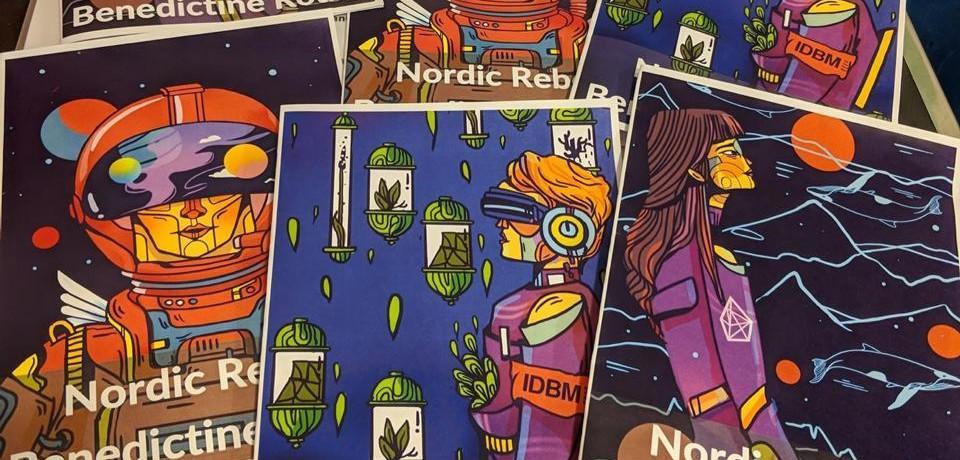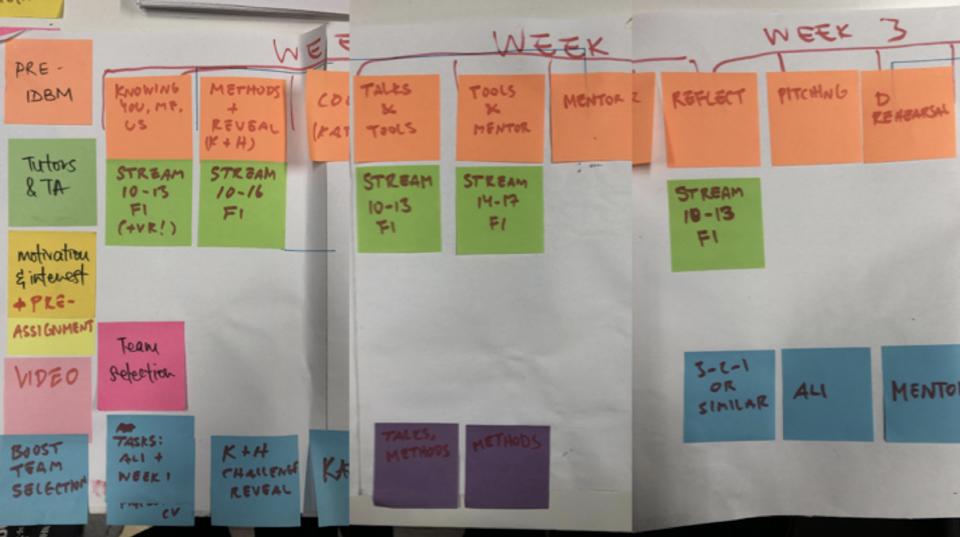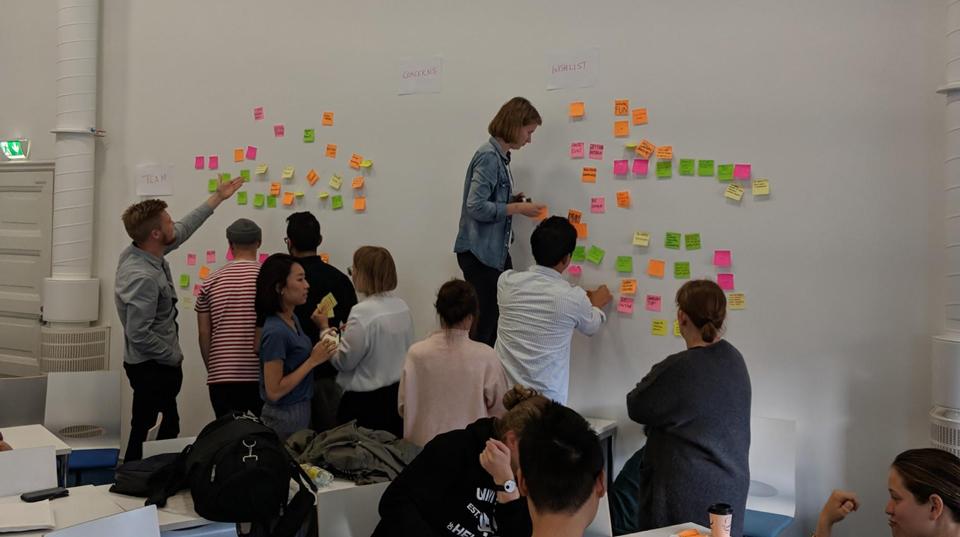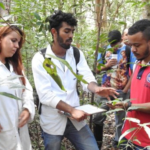
Miikka J. Lehtonen, Jia Ying Chew, Katharina S. Schilli & Adithya Varadarajan
Literature on learning in higher education institutions has focused attention on teaching generations that are more and more adept with and used to digital technologies. Similarly, from an educator’s point of view, research on blended learning or flipped classroom has increased our understanding of how technology could be utilized in the classroom. Despite greatly increasing the current body of knowledge on blended and online learning, most studies seem to have ignored the notion that supporting learning through technology is not only about technological optimization but about crafting meaningful learning experiences. In a similar vein, courses taught in higher education institutions are still predominantly teacher-centric, implying that the students are expected to conform to the course requirements instead of creating learning spaces where each party involved can actively participate in creating the experience. Thus, strategic, and pedagogical transformations are needed in higher education institutions in order to create learning experiences fit for the 21st century.
To offer one potential avenue to move forward, in this paper we position and discuss Nordic Rebels, a Danish-Finnish movement aiming at transforming learning in the context of higher education. Aiming at taking the university where the students are, Nordic Rebels utilizes design tools and methods in creating course spaces that both concretely and conceptually extend the Universal Design for Learning principles. Taking the students as the point of departure, we illustrate how design can be harnessed to create both strategic and pedagogical renewal in higher education institutions.
Introduction: how and why was Nordic Rebels created
In their seminal article on teaching the virtual generation, Proserpio and Gioia (2007) argued that internet and technological advances had created a need to create novel learning experiences for younger generations. While we do not agree with their somewhat superficial notion that younger generations no longer read books, we do, however, agree the time is ripe for a pedagogical revolution. But this revolution is not built on the premise of new technologies changing the way we communicate and forming connections with each other: instead, it is about creating conditions for learning experiences that students and instructors alike experience as meaningful or engaging. Or, as we have conceptualized, creating goosebumpifying learning experiences. We fully acknowledge the notion that to goosebumpify something is highly personal – and, simultaneously, the whole word bends English grammar – but on a more strategic level this is a question about how do we, as educators, transform existing course and program curricula to be more student-centric. Thus, the Danish-Finnish collaboration that is now referred to as the Nordic Rebels was established to take the university where the students are.
Although the Danish-Finnish collaboration that led to the formation of Nordic Rebels in the summer of 2018 emerged serendipitously one year earlier, all of us founding members felt there was a need for such an initiative well before the ‘formal’ identity was crafted. Literature on higher education has highlighted the need for educational institutions to transform or reinvent themselves (Proserpio & Gioia, 2007), but to date, most innovations have been of an incremental nature with more radical proposals being situated in the margins. While Nordic Rebels was not – at least consciously – informed by extant literature, along the way we have realized our approach to learning and education resonates well with Dewey (1930, 1938), hooks (1994), and Rose and Meyer (2002), to name but few examples.
To elaborate on our guiding vision a bit more, based on our own experiences as students and educators, we realized that existing higher education structures were created for streamlining learning. Or, as literature defines it, learning has predominantly been teacher-centric (Murtonen, Gruber, & Lehtinen, 2017). To counter this, we drew upon co-design methodologies and their human-centric ethos to adopt a more solution- or human-centered approach to crafting course contents and learning outcomes. As mentioned above, we wanted to create conditions for more student-centered learning experiences, and in this article, we document our journey from the perspective of how our solution materializes the Universal Design for Learning (UDL) framework (Meyer & Rose, 2000; Rose & Meyer, 2002).
Nordic Rebels and Universal Design for Learning (UDL): conceptual considerations
Initially developed in architecture, universal design principles were aimed at creating buildings and spaces that could be used by anyone regardless of their abilities. Although the Center for Universal Design (NC State University), originator of the universal design principles, no longer exists, their work has been widely adopted and developed in education as Universal Design for Learning (UDL) (see e.g. Edyburn, 2010; Meyer & Rose, 2000; Rose & Meyer, 2002). Perhaps because of its roots in architecture, or material, practice, UDL has often been understood to focus on the technological aspect of inclusiveness (King-Sears, 2009), but in effect UDL should be understood more broadly as designing spaces, methods, and content for learning that take into account individual needs and expectations (Courey et al., 2012; Edyburn, 2010; McLeskey & Waldron, 2007). As Edyburn (2010, p. 36) argues, UDL is not about infusing the curriculum with technology, but instead about creating a validated understanding of academic diversity to ensure individual differences amongst students do not negatively influence accessibility and engagement.
In the context of Nordic Rebels, we are teaching design and design management to a multidisciplinary and multicultural student body, with students often working in teams. Each year, approximately fifty to sixty students take our course, representing a balanced mixture of nationalities, genders, disciplines, and prior work experience. Since roughly one third of our students come from design, adopting the ‘lowest common denominator’ approach to teaching design would not only frustrate the design students, but as a consequence also prevent them from sharing their expertise. What is more, as a considerable number of our students are working alongside their studies, we are balancing between a multitude of requirements, which is why we decided to design the course curriculum and experience from the students’ point of view. Thus, we created content (video episodes and podcasts, for instance) and utilized digital tools in a streamlined fashion (i.e. keeping the number of different tools at minimum) and simultaneously highlighted the community-driven approach to learning to emphasize that our students were responsible not only for their own learning but also that of their peers. Whereas the online content enabled our students to prepare for the workshop sessions at their own pace (some told us they were listening to the podcasts while running or cleaning their home), the community-driven approach ensured everyone could contribute to their teamwork regardless of their English skills or prior experience in design.
Utilizing design for teaching design: Nordic Rebels as a learner-centric movement
Since we are teaching a multidisciplinary and multicultural student body, the team behind Nordic Rebels also reflects the same diversity. What started with the first author running the course alone in 2016, has now expanded into a core team of three disciplines (business, technology, and design) and five nationalities (Denmark, Finland, Germany, India, and Singapore). Moreover, while the core team consists of design-driven educators, the extended team involves several freelancers: a graphic designer, a virtual reality consultant, an audio designer, and a videographer. At this point, however, it has to be pointed out that no-one from the team engages with Nordic Rebels on a full-time basis – with this, we wish to show that our pedagogical innovations do not require acquiring significant amounts of resources, but instead it is more about efficiently utilizing already existing resources in the university ecosystem. For example, our videographer’s tasks in the university include shooting and producing pedagogical videos, and some of the teaching methods we have created draw on existing data collected by our partners.
For the 2018 iteration of the course, we decided to integrate design methods and processes more systematically into our course design process in comparison with the previous versions. As the ethos of design relies heavily on human-centricity, we hypothesized that utilizing design to teach about design to our students would enable us to better take into account different approaches to learning as well as ensure everyone would be more or less on the same baseline when the course commenced. For example, we utilized the service blueprint – originally devised in the marketing discipline, then adopted by service designers – to craft the course journey from the student’s point of view, highlighting what needs to be done before, during, and after the course. The figure below is an excerpt from one of the service blueprint iterations we crafted when designing the course.

Above, all the activities from both the student and instructor side have been laid out from the student’s point of view. All the way from the onboarding to handing out the final deliverables, the service blueprint visualizes the course structure in a way that focuses on the student’s experience. This approach to course design serves two purposes: first, it provides the instructor with a clearer sense of what needs to be done and when for the course to flow smoothly; and second, it also enables changes along the way as the instructor can see how changes would inform upcoming sessions. For instance, we ended each week of this intensive three-week course with a reflection session (based on our previous experiences during the 2017 iteration as well as student feedback) that provided our students with a space to voice their wishes and concerns for the upcoming weeks.

In Figure 2 above, our students are attaching sticky notes on the wall and these notes contain both wishes and concerns for the upcoming week. While we cannot be certain to what extent the students were being sincere in their opinions and thoughts, providing a safe space for the students to have their say during the course was already something they seemed to appreciate. This, naturally, quickly boils down into issues of trust: by sharing their wishes and concerns, the students were placing tremendous amount of trust in us as instructors to act upon their ideas. To continue building trust between us, we started the following weeks with a brief session illustrating how we changed or tweaked the course flow based on their feedback.
In addition to taking the time to iteratively develop the course design on the go, we also emphasized the importance of personal reflections. Whilst it is relatively easy to fill courses with numerous topics and themes, we have come to realize devoting time for reflections throughout the course is crucial in terms of supporting students’ learning. Especially in course environments relying on learning through doing, it is important from time to time to step back and allow time for reflection. The first and fourth authors of this paper experienced one such method in a conference in Copenhagen, Denmark, during the summer of 2018: the Benedictine Round. Essentially it involves walking for thirty minutes outside in silence with a partner, and then gathering in groups of four to five to take turns in sharing whatever everyone has on their mind regarding what they have learned during the week.
While we did not modify the actual process of Benedictine Round, we branded the method’s instructions with the Nordic Rebels identity (see the main image of the article above) in order to maintain aesthetic consistency across the course material. This again ensured the students felt everything was curated for them to allow for a smooth course flow.
To conclude, we utilized design tools and methods to craft a learning space that would ensure the students could feel the experience had been designed specifically for them. Some of the tools – like the service blueprint – served as sort of backstage tools, whereas the Nordic Rebels Benedictine Round (see above) was something the students experienced directly. What is worth highlighting here is the student-centric ethos: when the course structure contains a certain sense of flexibility, it is possible to make changes to it as the course progresses. This, we believe, has been one of our core strengths as it makes visible to the students what we are doing to take their needs and wishes into account.
Measuring feedback and tracing the emergence of social agency
As part of their public funding, the Ministry of Education and Culture expects higher education institutions in Finland to collect student feedback from each course based on the guidelines set out by the Ministry. For us, too, this was one of the means to collect feedback, but since it only impacts the preceding iteration, we complemented that with weekly reflection sessions as well as visual learning diaries that was one of the individual assignments for the students to hand in to successfully complete the course. This triangulation ensured we had multiple viewpoints on evaluating and improving the course both in terms current and future iterations.
As discussed above, we hosted weekly reflection sessions each Friday to get a good understanding of how the students are feeling about the course contents and direction. We are not advocating here a sense of showboating: changes to the course were not made to ensure better student feedback at the end of the course, but to ensure they experience a learning space that supports their learning. We documented each reflection session and shared the collated information also with our students to ensure transparency in our decisions to tweak the course on the go.
At the end of the course, we also asked each student to hand in an individual assignment reflecting on their learning journey. Inviting the students to craft a visual learning diary was an insightful means for us to tap into the emotional side of our students’ learning as well as gently nudge them to reflect on their learning both verbally and visually. These visual learning diaries have also provided us with research data for manuscripts as well as insights on how to further develop the course.
To conclude, we collected both qualitative and quantitative feedback on the course. The mean rating for the 2018 iteration, on a scale from zero to five, was 4,44 and verbal feedback collected in the same form supports this evaluation. While it also indicates there is room for improvement, it clearly illustrates the benefits of designing student-centric course spaces that aim at taking the university where the students are.
Conclusion: pedagogical insights from the Nordic Rebels
When we started the Danish-Finnish collaboration during the summer of 2017, we had no idea our activities would have the potential to become a movement inspiring transformation in higher education institutions. To this end, we have experienced tremendous learning experiences and in this article, we have tried to document our journey so far. With this concluding section, we would like to focus on what we have learned over the years, how Nordic Rebels has made us aware of our challenges and strengths as educators, and what we are currently planning.
To begin with, Nordic Rebels for us has been a manifestation of the myriad ways the educator’s role is changing. We are not advocating the death of lecturing, but at the same time we cannot stress enough how the educator’s role is broadening from a lecturer to a producer / director, facilitator, and companion. The educator’s role no longer is about being the sage on the stage, but the driving force in helping the students become the superstars, because in the end, we as educators work in higher education institutions to help our students grow. Moreover, focusing on students’ growth also enables us as educators to develop our competencies: creating audio and video episodes for Nordic Rebels is one explicit manifestation of the educator’s changing roles. Creating such content requires a specific mindset, and the episodes in our first season were deemed as too long by our students. Acknowledging the feedback, we ended up condensing the episodes and paying more attention to carefully directing and curating the episodes. Furthermore, through producing these seasons (as of writing this article, we are wrapping up the production of season three) we have also come to realize higher education institutions are full of talent. Our audiovisual identity, for instance, is fully developed by students of Aalto University, and the production of our audiovisual content is predominantly made possible by internal resources at Aalto University.
While learning tremendously from pushing the envelope on Nordic Rebels, at the same time we are also exposed to challenges as well as our strengths. One potential challenge we have identified focuses on inclusiveness: even though the team behind Nordic Rebels is both multidisciplinary and multicultural, we are still designing courses from a certain vantage point. Thus, how do we draw on existing research and theories to make Nordic Rebels more inclusive, and how do we communicate this to our students to ensure they are aware of our design decisions? While this sounds like a relatively grand challenge, at the same time some of our strengths – transdisciplinary and a strong sense of trust and safe space – ensure that we can explore matters in a constructive fashion.
Finally, a few words about the future of Nordic Rebels. Based on our experiences running courses under the Nordic Rebels identity, we have come to realize our initiatives find resonance not only amongst our students but also internationally. To this end, our future endeavors focus on continuing to broaden the scope from a course to a whole minor program, developing a program for educators, and co-developing new teaching tools and methods with our international collaborators. While this is only our hypothesis, we believe the higher education sector is ripe for movements that provide students and educators alike with a safe space to engage in and create new kinds of transformative learning experiences. After all, transforming something as archaic as higher education institutions is not a task for one person, which is why we are constantly on the lookout for new partners in this collective endeavor.
Authors
Miikka J. Lehtonen is a multidisciplinary academic with a research and teaching focus on engineering, design, and business. He believes in learning by doing, and this belief is reflected in his teaching methods. As a consequence, in 2018 he and his colleagues established Nordic Rebels, a movement transforming learning and higher education. Miikka has worked on projects and teaching assignments in Finland and Japan. He also has experience teaching in Denmark, the United States, Russia, India, and China.
Jia Ying Chew is a design strategist with a passion for social innovation and education. She believes that designers are “shapeshifters” and that they play an instrumental role in evolving existing systems, if (and when) they are given the opportunity. Multidisciplinary at heart, she has a background in project and facilities management that shaped her interests in integrated systems and businesses, while her industrial design training has honed her sensibilities to form and function. Her work as a service design researcher also enabled her to have a better understanding on collaborative methods and stakeholder engagement.
Katharina S. Schilli is a Nordic Rebel and PhD student at the University of Turku, collaborating with corporations, start-ups, and academia. She works at the intersection of theory and practice to foster collaborative work environments and internal value creation. Katharina’s early expertise in architecture has shaped her interest in complex ecosystems, capturing their fundamental patterns and incorporating human-centered perspectives. As a member of the Nordic Rebels Movement she creates memorable learning experiences, empowering changemakers to tackle the grand challenges of today and tomorrow.
Adithya Varadarajan is an Education Designer with the Nordic Rebels, and a student of the IDBM masters programme at Aalto University. With a background in Design Strategy and UX/Product Design, he has worked as a design consultant across a wide range of domains and locations. He is passionate about creating strategic and systemic solutions and incorporating emerging technologies (AI, AR, VR, IoT). With Nordic Rebels, his focus is on evolving educational experiences beyond the traditional classroom environment, and helping take education to where the students are.
References
Courey, S. J., Tappe, P., Siker, J., & LePage, P. (2012). Improved Lesson Planning With Universal Design for Learning (UDL). Teacher Education and Special Education, 36(1), 7–27.
Dewey, J. (1930). Democracy and education: An introduction to the philosophy of education. Norwood, MA: Norwood Press.
Dewey, J. (1938). Experience and education. New York, NY: Touchstone.
Edyburn, D. L. (2010). Would you recognize universal design for learning if you saw it? Ten propositions for new directions for the second decade of UCL. Learning Disability Quarterly, 33(1), 33–41.
hooks, b. (1994). Teaching to transgress. New York, NY: Routledge.
King-Sears, M. (2009). Universal design for learning: Technology and pedagogy. Learning Disability Quarterly, 32(4), 199–201.
McLeskey, J., & Waldron, N. L. (2007). Making Differences Ordinary in Inclusive Classrooms. Intervention in School and Clinic, 42(3), 162–168.
Meyer, A., & Rose, D.H. (2000). Universal design for individual differences. Educational Leadership, 58(3), 39–43.
Murtonen, M., Gruber, H., & Lehtinen, E. (2017). The return of behaviourist epistemology: A review of learning outcomes studies. Educational Research Review, 22, 114–128.
Proserpio, L., & Gioia, D.A. (2007). Teaching the virtual generation. Academy of Management Learning & Education, 6(1), 69–80.
Rose, D., & Meyer, A. (2002). Teaching every student in the digital age. Alexandria, VA: ASCD.





